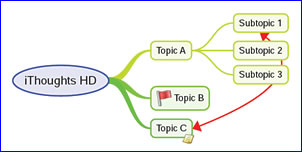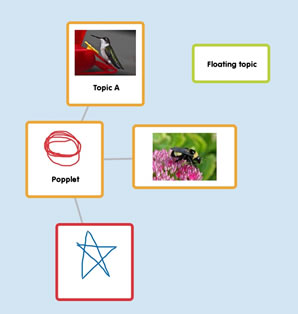 Last week, I finally got my hands on an Apple iPad. What an amazing machine! As promised, here are my first impressions of the mind mapping apps that are now available:
Last week, I finally got my hands on an Apple iPad. What an amazing machine! As promised, here are my first impressions of the mind mapping apps that are now available:
iMindMap: This app is everything you would expect from iMindMap. The experience of creating new map topics with your index finger just feels right. The app supports all of the capabilities that I consider to be important In mind mapping applications, including notes, hypertext links and icons.
iThoughts HD: This full-featured app gives you a surprising level of control over the look and feel of your mind maps. The shape and color of topics, icons and start and due dates can be set via a simple multi-tabbed dialog box. Surprisingly, iThoughts HD does auto-versioning, which enables you to roll back your mind map to a previous version. Very cool! This well-designed app can export your maps in no less than 7 different formats, including PDF, Freemind, MindManager, PNG, OPML (an outline format), Novamind, iMindmap and Mindview. Other excellent features include the ability to sync your maps with cloud-based storage services Dropbox and box.net, unlimited undo and redo, and the ability to turn on or off inheritance of topic colors and shapes. iThoughts HD is the undisputed leader in the iPad mind mapping space.
MindMeister for iPad: This app appears to be well designed and easy to use. It’s claim to fame is its tight integration with the online MindMeister service; as on the iPhone, you can work with mind maps you have created locally on the iPad, or you can access the maps in your online message store and save new maps to this location – ideal for capturing ideas on the iPad and then fleshing them out in the MindMeister web application. In its first iteration, MindMeister for iPad didn’t support links, tasks or notes. But with its latest release, these features are now supported and work very well.
MindNode: This app has a fairly limited feature set, but does the basics very well. When you select a topic, a plus sign appears next to it. Tap on it, and a new subtopic is created, awaiting you to name it. Not quite as organic as iMindMap’s organic tap-and-drag motif, but wonderfully efficient nonetheless. What’s nice about it is that you can add new topics without having to use the toolbar button at the top of the screen. If your mind mapping needs are fairly basic, then MindNode is a solid choice!
SimpleMind: Like its name suggests, SimpleMind has a fairly simple user interface and only the most basic of features – adding topics and sub-topics, and changing their color, either via a set of builts in styles or by selecting a topic and adjusting the color manually. Almost too basic, I think.
Mindo: This app also has a fairly basic set of features, but can create boundaries around groups of topics and relationship lines – features not found on any other iPad mind mapping app.
 CrowdMap: This is a fairly new mind mapping app that aims to make it easy for people to share maps with each other. However, the features are just too basic at this time. All it can do is create topics, subtopics and change their color. As I’ve mentioned before in this blog, even the most basic mind mapping app needs to support icons, hypertext links and notes – the basics for capturing at least a moderate level of detail about the topic you’re brainstorming.
CrowdMap: This is a fairly new mind mapping app that aims to make it easy for people to share maps with each other. However, the features are just too basic at this time. All it can do is create topics, subtopics and change their color. As I’ve mentioned before in this blog, even the most basic mind mapping app needs to support icons, hypertext links and notes – the basics for capturing at least a moderate level of detail about the topic you’re brainstorming.
Popplet: This interesting app does something akin to mind maps, except with topic shapes that can contain any combination of words, images and drawings. The effect is playful, rather than professional. Still, an interesting app nonetheless.
I’m excited to see how far the genre of mind mapping apps has come in the 4 months since Apple’s launch of the iPad in June. I can’t wait to see what’s coming next!

Leave a Reply